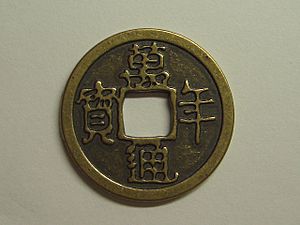Tenpyō-hōji facts for kids
Tenpyō-hōji was a special time period in Japanese history. It was an "era name" (called nengō in Japanese). This era came after the Tenpyō-shōhō era and before the Tenpyō-jingo era.
The Tenpyō-hōji period lasted from August 757 to January 765. During this time, two important rulers were in charge: Emperor Junnin and Empress Shōtoku.
Key Events of the Tenpyō-hōji Era
- 757: The Tenpyō-hōji era officially began in the eighth month of what was then the ninth year of the Tenpyō-shōhō era. This marked a new start for the calendar.
- 760: New types of money were created and started being used. There were copper coins, silver coins, and gold coins. Each type of coin had different words written on it. For example, the copper coins said Mannen Ten-hō.
- 765: On January 26, Emperor Junnin was removed from his position. The former Empress Kōken then took over as the new ruler. Soon after, her rule was officially confirmed through special ceremonies. She became known as Empress Shōtoku.
Related Information
- Nara period
- National Diet Library, "The Japanese Calendar" -- historical overview plus illustrative images from library's collection
See also
 In Spanish: Tenpyō-hōji para niños
In Spanish: Tenpyō-hōji para niños

All content from Kiddle encyclopedia articles (including the article images and facts) can be freely used under Attribution-ShareAlike license, unless stated otherwise. Cite this article:
Tenpyō-hōji Facts for Kids. Kiddle Encyclopedia.

